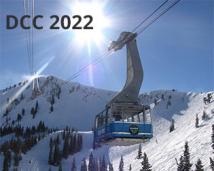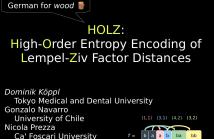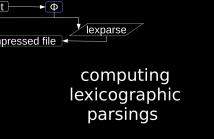
DCC 2022 Conference - The Data Compression Conference (DCC) is an international forum for current work on data compression and related applications. Both theoretical and experimental work are of interest. Visit the DCC 2022 website.

- Read more about A New Parametric Coding Method Combined Linear Microphone Array Topology
- Log in to post comments
The existing low bit rate multi-channel audio coding schemes basically depend on parametric model related to the psychoacoustics. On this basis, this paper aims at the linear microphone array, in which the redundancy between the array topology and signal is inventively exploited so that the coding efficiency is improved well. Compared with the classical schemes, the new parametric coding scheme proposed here effectively minimizes the amount of space parameters that need to be transmitted and greatly save the cost of transmission resources.
- Categories:
 28 Views
28 Views
- Read more about DNN-based Multi-Channel Speech Coding Employing Sound Localization
- Log in to post comments
In this paper, a novel multi-channel speech coding method based on deep neural networks (DNN) employing sound localization called time difference of arrival (TDOA) is proposed. At the encoder, only the speech signals of two reference channels and estimated TDOAs are coded. At the decoder, a well-trained DNN that builds the relationship of the amplitude spectra between two reference channels and other channels is embedded into the decoder for recovering the amplitude spectra of other channel signals from two decoded reference signals.
- Categories:
 50 Views
50 Views
- Read more about Chunk Content is not Enough: Chunk-Context Aware Resemblance Detection for Deduplication Delta Compression
- Log in to post comments
With the growing popularity of cloud storage, identifying and removing duplicate data across users is getting more critical for service providers. Thus, many researchers have attracted attention for data resemblance to detect redundancy among similar data. It uses feature extraction to detect data chunks with high similarity first, and then treat them as candidates for removing redundancy.
- Categories:
 176 Views
176 Views
- Read more about HOLZ: High-Order Entropy Encoding of Lempel-Ziv Factor Distances
- Log in to post comments
We propose a new representation of the offsets of the Lempel-Ziv (LZ) factorization
based on the co-lexicographic order of the text's prefixes.
The selected offsets tend to approach the k-th order empirical entropy.
Our evaluations show that this choice is superior to
the rightmost and bit-optimal LZ parsings on datasets with small high-order entropy.
- Categories:
 49 Views
49 Views
- Read more about Computing Lexicographic Parsings
- 2 comments
- Log in to post comments
We give memory-friendly algorithms computing the compression schemes lexparse in linear time.
- Categories:
 75 Views
75 Views
- Read more about Fast Coding of Haar Wavelet Trees
- Log in to post comments
Tarter_DCC.pdf
- Categories:
 81 Views
81 Views
- Read more about Keyframe Insertion for Fast Channel Switching & Packet-Loss Repair in Low-Delay Live Streaming
- Log in to post comments
Keyframe insertion is a solution for fast channel switching and packet-loss repair in low-delay live streaming.
This work lists the requirements of keyframe insertion in three generations of video coding standards (H.264/AVC, H.265/HEVC, and H.266/VVC), and analyzes the quality impact.
- Categories:
 71 Views
71 Views
- Read more about An Improved Multi-reference Frame Loop Filter Algorithm Based on Transformer for VVC
- Log in to post comments
Deep learning methods have been achieving good results at the in-loop filtering stage in Versatile Video Coding(VVC). The Multi-Frame In-Loop Filter of HEVC (MIF) algorithm is one of the networks that effectively utilizes the multiple reference frames to enhance the quality of reconstruction. However, it has the disadvantages of low efficiency of the reference frame selection, and its quality enhancement network does not fully utilize the inter-frame correlations of the video sequence and has large redundancy.
- Categories:
 50 Views
50 Views
- Read more about A fast geometric prediction merge mode decision algorithm based on CU gradient for VVC
- Log in to post comments
Geometric prediction merge mode (GPM) is a new tool introduced in the inter-prediction of Versatile Video Coding (VVC), which uses non-rectangular block partitions for coding unit (CU) partition to improve coding performance. To address the problem of large computational redundancy in the geometric prediction merge mode with motion vector refinement (GPM with MMVD), in this paper, a new decision algorithm is proposed based on CU gradient.
- Categories:
 87 Views
87 Views